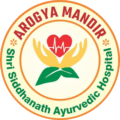Asthma

I. Introduction
Asthma, a chronic respiratory condition affecting millions worldwide, has been a subject of extensive study in various medical systems. In this article, we delve into the intricate world of Asthma through the lens of Ayurveda, an ancient Indian system of medicine that offers a unique perspective on health and wellness.
Asthma is acute or chronic disorder in which respiration becomes difficult and proper ventilation reduces. Thus, it may damage vital organs if doesn’t treated well. Asthma can be congenital.
In Ayurved, it is told that we get energy through Praan (air which we inhale inside). This Praan vayu is dry in nature. But everything in body except Vaat dosha is oily or wet. So for reducing dryness of praan vayu, our body keeps the Kapha dosha in respiratory system i.e. Chest. Excessive oiliness of Kapha dosha reduces dryness and make praan vayu more comfortable to take inside of our body. But in some condition, this kapha dosha increases than normal level and leads to various disorders. like –
cold if kapha increases in upper respiratory tract,
cough if kapha increases in middle respiratory tract
asthma if kapha increases in lower respiratory tract.
We need kapha in proper quality and quantity for proper functioning of respiratory system.
In Ayurveda, Asthma is defined as “Tamaka Shwasa,” characterized by impaired breathing and wheezing. The doshas, Vata, Pitta, and Kapha, play a pivotal role in the manifestation of Asthma symptoms. Identifying triggers such as environmental factors, stress, and dietary habits is crucial in Ayurvedic diagnosis.
II. Ayurvedic View of Asthma
1. Causes of Asthma in Ayurveda.
- Frequent exposer to dust or any minute particles which can be inhaled through inspiration.
- Exposure to cold weather, eating of cold food
- Excessive exercises.
- Frequent intake of dry food
- Excessive dieting.
- Some foods like sesame, curd, non-pasteurized or non-boiled milk etc.
2. Steps of Asthma occurrence according to Ayurveda.
- Individuals predisposed to asthma and exposed to frequent causative factors.
- Results in an accumulation of kapha in the chest region.
- The body initiates mechanisms to maintain equilibrium.
- External elements such as dust or the rainy season can trigger an increase in kapha production.
- The body struggles to maintain balance.
- Kapha dosha accumulates in the respiratory tract.
- This accumulation obstructs the pathway of praan vayu.
- Leads to diminished energy levels in body cells.
- The brain attempts to boost respiration to meet cellular requirements.
- Despite increased respiration, proper ventilation is hindered due to the obstruction of kapha dosha.
- Resulting in difficulty in breathing.
- As kapha reduces, the obstruction lessens, and asthma symptoms decrease.
- Exposure to factors like dust triggers kapha production again.
- Subsequently, symptoms reappear.
- This cycle leads to frequent episodes of breathlessness.
- Culminating in the manifestation of asthma.
3. Pre-disease signs of Asthma
- Heaviness in abdomen and chest
- Palpitations
- Pain in back and in Shankha region
- Difficulty in expiration
- Loss of interest in food
4. Signs and symptoms of Asthma in Ayurveda.
- Severe breathlessness
- Cold & Cough
- Heaviness in chest
- Difficulty increases during sleeping position and reduces during seating position.
- Sleep hampered
- Sweating
- Symptoms increases during rainy season, cold weather etc
III. Ayurvedic Diagnosis
Here are key aspects of the Ayurvedic diagnostic process for Asthma:
Pulse Diagnosis (Nadi Parikshan):
- Ayurvedic practitioners often use pulse diagnosis to assess the balance of doshas and identify any irregularities. Changes in the pulse may indicate the presence of doshic imbalances associated with Asthma.
Tongue Examination (Jihva Parikshan):
- The appearance of the tongue can provide insights into digestive health and the presence of ama (toxins) in the body.
Physical Examination (Rogi Parikshan):
- A thorough physical examination includes assessing the respiratory assessment.
Detailed History and Symptoms (Roga Nidana):
- Gathering a detailed medical history and understanding the specific symptoms experienced by the individual are crucial.
Dosha Assessment:
- Understanding the predominant dosha involved in the manifestation of Asthma is essential. Kapha dosha imbalance is often a primary factor, accompanied by contributions from Pitta and Vata doshas.
- Evaluating the individual’s inherent constitution (Prakruti) helps determine their natural tendencies and susceptibilities. It provides a baseline for understanding how doshic imbalances may contribute to the development of Asthma.
Mental and Emotional Assessment:
- Recognizing the impact of mental and emotional factors on the condition is vital. Stress, anxiety, or depression can exacerbate symptoms and influence doshic imbalances.
Diagnostic Tools (Ashtavidha Parikshan):
- Ayurveda employs various diagnostic tools, including examining urine (Mutra Parikshan), stool (Mala Parikshan), and assessing factors like pulse, voice, and body constitution (Prakruti).
Imaging and Laboratory Tests:
- While Ayurveda primarily relies on traditional diagnostic methods, modern diagnostic tools such as X-rays or blood tests may be used to complement the Ayurvedic assessment and confirm the diagnosis.
IV. Ayurvedic Treatment Approaches
A. Dietary recommendation
1. Warm and Light Foods:
- Consume warm, freshly cooked meals.
- Choose light and easily digestible foods to prevent the accumulation of ama (toxins) in the body.
- Take foods that are easy to digest, such as well-cooked grains like quinoa and basmati rice.
- Practice moderation in portion sizes to prevent overeating, which can contribute to Kapha imbalance.
2. Spices and Herbs:
- Incorporate spices known for their anti-inflammatory properties, such as turmeric, ginger, and black pepper.
- Use herbs like fenugreek, cumin, and coriander in cooking, as they aid digestion and help balance Kapha.
3. Limit Cold and Heavy Foods:
- Reduce the intake of cold and heavy foods, including dairy products, deep-fried foods, and excessive sweets.
- Cold foods can contribute to mucus formation, aggravating respiratory symptoms.
4. Hydration:
- Drink warm water throughout the day to help flush out toxins and maintain proper hydration.
- Avoid consuming very cold or iced beverages.
5. Honey:
- Use raw honey, as it is considered beneficial for respiratory health.
6. Fruits, Nuts and Seeds:
- Choose fruits that are ripe and seasonal.
- Favor fruits with astringent and pungent tastes, such as apples, pears, and berries.
- Include moderate amounts of nuts and seeds, especially almonds and flaxseeds, for their nutritional benefits.
7. Vegetables:
- Include a variety of cooked vegetables in your diet.
- Emphasize vegetables with bitter and astringent tastes, such as leafy greens, broccoli, and Brussels sprouts.
8. Avoid Trigger Foods:
- Identify and avoid specific foods that may trigger allergic reactions or worsen asthma symptoms. Some of them are curd, sugarcane juice, jaggery in excess, cold drinks and banana.
9. Avoid Processed Foods:
- Minimize the intake of processed and refined foods, as they can contain additives and preservatives that may exacerbate respiratory issues.
It’s essential to remember that individual dietary needs may vary, and consulting with an Ayurvedic practitioner for personalized advice based on your specific constitution and imbalances is recommended.
B. Herbal remedies for Asthma.
Ayurveda incorporates various herbs that are believed to be beneficial in managing asthma symptoms by addressing underlying imbalances and promoting respiratory health. Here are five Ayurvedic herbs commonly used in the treatment of asthma:
1. Turmeric (Curcuma longa):
- Known for its anti-inflammatory and antioxidant properties, turmeric is often used to alleviate inflammation in the respiratory tract.
- It can be consumed in the form of capsules, powder, or added to warm milk.
2. Licorice (Glycyrrhiza glabra):
- Licorice has anti-inflammatory and bronchodilator effects, making it useful in relieving bronchial spasms and soothing the respiratory system.
- It can be consumed as a tea, in powder form, or as a part of herbal formulations.
3. Tulsi (Holy Basil, Ocimum sanctum):
- Tulsi is renowned for its anti-allergic and immune-modulating properties.
- It can be consumed as a tea or as part of herbal formulations, providing relief in respiratory conditions.
4. Adhatoda (Vasaka, Justicia adhatoda):
- Vasaka is commonly used in Ayurveda for its bronchodilator and expectorant properties.
- It is often included in herbal formulations aimed at promoting respiratory health.
5. Shankhpushpi (Convolvulus pluricaulis):
- Shankhpushpi is known for its calming effects on the nervous system and its potential to reduce stress-related triggers for asthma.
- It is often used in Ayurvedic formulations to support overall well-being.
It’s crucial to consult with an Ayurvedic practitioner before incorporating these herbs into your routine, as individual responses may vary, and proper dosage and combination with other herbs need to be considered.
C. Ayurvedic Therapies for Asthma
1. Abhyanga And Swedana (Massage and Sweating Therapy):
- Abhyanga involves a therapeutic oil massage, which can be specifically targeted to the chest and back in the case of asthma.
- The massage helps improve circulation, reduce stiffness, and alleviate congestion in the respiratory system.
- Swedana involves inducing sweat to eliminate toxins and reduce Kapha congestion in the respiratory system.
- Common methods include steam therapy or warm poultices applied to the chest with specific herbal formulations.
2. Vamana (Therapeutic Vomiting):
- Vamana is a detoxification therapy that aims to expel excess Kapha from the body.
- This controlled emesis process is performed under the guidance of a qualified Ayurvedic practitioner.
3. Nasya (Nasal Administration):
- Nasya involves the administration of medicated oils or herbal preparations into the nostrils to clear the respiratory passages.
- This therapy helps in reducing congestion and promoting proper breathing.
It’s crucial to undergo these therapies under the supervision of a qualified Ayurvedic practitioner who can tailor the treatments based on individual needs and doshic imbalances.
V. Yoga and Pranayama for Asthma
Yoga and pranayama, the practice of controlled breathing, can be valuable components in managing asthma symptoms and improving overall respiratory health. Here are specific yoga and pranayama techniques that individuals with asthma may find beneficial:
- Bhujangasana (Cobra Pose):
- Tadasana (Mountain Pose):
- Sukhasana (Easy Pose) with Pranayama:
- Kapalbhati (Skull-Shining Breath):
- Anulom Vilom (Alternate Nostril Breathing):
- Ujjayi Pranayama (Victorious Breath):
- Setu Bandhasana (Bridge Pose):
- Marjarasana (Cat-Cow Pose):
FAQs
- Ayurvedic treatments are generally safe when administered by qualified practitioners. However, individual responses may vary.
While Ayurveda may provide significant relief and management, claiming a complete cure depends on various factors, including the severity of the condition and individual health.
Ayurveda recommends avoiding certain foods that may trigger Asthma symptoms. A personalized diet plan is often suggested.
Results vary among individuals. Some may experience improvement in symptoms relatively quickly, while others may require more time.
Uniqueness of our therapies
At Arogya Mandir – Shri Siddhanath Ayurvedic Hospital, Miraj, we delve deeply into the ayurvedic examination of each patient. Utilizing noninvasive Ayurvedic diagnostic tools such as Ashtavidha Parikshan and Nadi Parikshan, we precisely determine the pathogenesis of the disease and then prescribe therapies tailored to the specific condition. This approach leads to expedited results.
Our therapies boast the following distinctive features:
– Tranquil and hygienic therapy rooms staffed with trained therapists in a positive environment.
– Selection of appropriate massage oil based on the patient’s Prakruti and the condition of the disease.
– Complimentary Prakruti and Dhatu Sarata examinations before the commencement of therapies.
– Authenticated procedures for each therapy.
– Judicious use of herbal medicines and instruments during the therapy sessions.
– Specialized rooms equipped with all facilities for inpatient care.
Feel free to share this article at no cost.
Copyright message – Dr. Prashant Chivate has published this article on drchivateayurved.org for informational purposes about diseases. Any other use of this article is strictly prohibited. All rights reserved.
